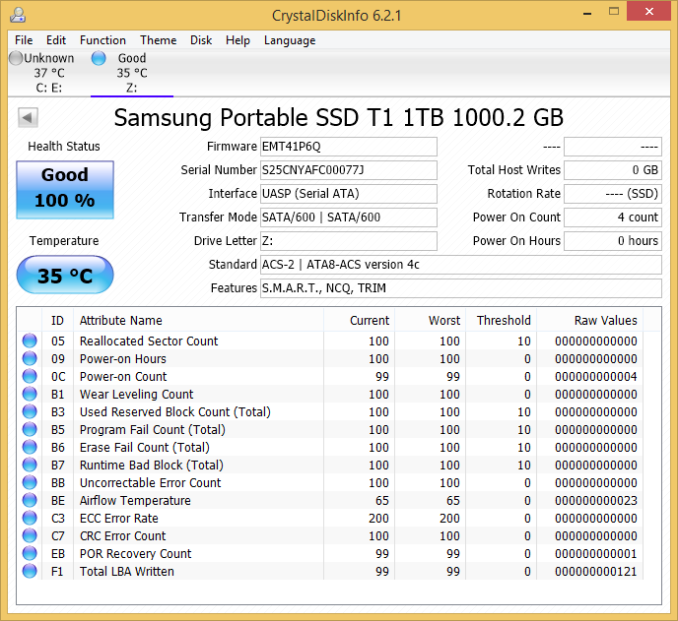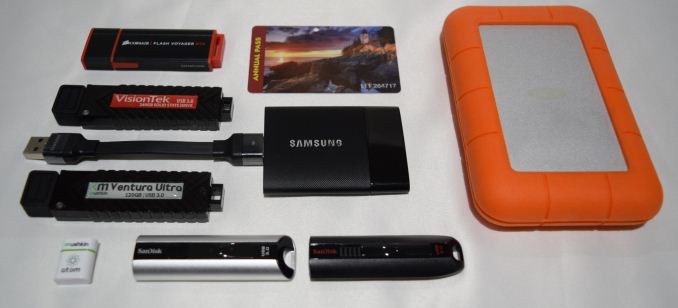Samsung Portable SSD T1 Review
by Ganesh T S on January 20, 2015 10:00 AM EST
Introduction and Testing Methodology
The last few years have seen rapid advancements in flash technology and the rise of USB 3.0 as an ubiquitous high-speed interface on computers. These have led to the appearance of small and affordable direct attached storage units with very high performance for day-to-day data transfer applications. We have already looked at some flash drives with SSD controllers and a USB 3.0 - SATA bridge over the last couple of months. These include the Corsair Flash Voyager GTX 256GB using the Phison S9 controller and the Mushkin Ventura Ultra using the SandForce SF2281 controller respectively.
At CES 2015, Samsung introduced the Portable SSD T1. With the introduction of the T1, Samsung becomes the first tier one manufacturer to enter the external SSD market (if you discount SanDisk's Extreme PRO USB 3.0 flash drives, which, despite being a SSD behind a USB 3.0 - SATA bridge, was never advertised as one). Hardware wise the T1 is based on the 850 EVO, meaning that the T1 uses 32-layer TLC V-NAND and the same full-fledged MEX/MGX SSD controller. CrystalDiskInfo gives us further insight into the unit.
Even though CrystalDiskInfo reports TRIM as a feature, we were unable to get it to work through the bridge configuration. In any case, Samsung also doesn't make any claims about TRIM support. S.M.A.R.T data was not visible to most of the commonly used tools. On the USB 3.0 side, the drive supports UASP (USB-attached SCSI Protocol) that should provide increased performance for sequential transfers. Claimed transfer rates are 450 MBps for sequential accesses and 8K read IOPS / 21K write IOPS. We also have hardware-accelerated AES-256 encryption.
Our review unit was pre-formatted in exFAT. Upon connecting to our testbed, a 128 MB FAT32 partition popped up and provided directions for installing the software / service that allows for the drive to be monitored / utilized with encryption capabilities. After installation, the 128 MB partition disappeared, and the 1 TB volume was made visible. The Samsung SSD program / daemon continues to run in the background and allows for altering the security option (encryption) without reformatting the partition. The gallery below shows the UI of the software running on Windows 8.1 Pro.
Testbed Setup and Testing Methodology
Evaluation of DAS units on Windows is done with the testbed outlined in the table below. For devices with USB 3.0 connections (such as the Samsung Portable SSD T1 that we are considering today), we utilize the USB 3.0 port directly hanging off the PCH.
| AnandTech DAS Testbed Configuration | |
| Motherboard | Asus Z97-PRO Wi-Fi ac ATX |
| CPU | Intel Core i7-4790 |
| Memory | Corsair Vengeance Pro CMY32GX3M4A2133C11 32 GB (4x 8GB) DDR3-2133 @ 11-11-11-27 |
| OS Drive | Seagate 600 Pro 400 GB |
| Optical Drive | Asus BW-16D1HT 16x Blu-ray Write (w/ M-Disc Support) |
| Add-on Card | Asus Thunderbolt EX II |
| Chassis | Corsair Air 540 |
| PSU | Corsair AX760i 760 W |
| OS | Windows 8.1 Pro |
| Thanks to Asus and Corsair for the build components | |
The full details of the reasoning behind choosing the above build components can be found here.
Samsung Portable SSD T1 - Size Comparison (standard credit card size also pictured for a frame of reference)
The list of DAS units used for comparison purposes is provided below.
- Samsung Portable SSD T1 1TB
- Corsair Voyager GTX 256GB
- LaCie Rugged Thunderbolt 500GB
- Mushkin Atom 64GB
- Mushkin Ventura Ultra 120GB
- SanDisk Extreme 64GB
- SanDisk Extreme PRO 128GB
- VisionTek Pocket SSD 240GB


















68 Comments
View All Comments
mczak - Wednesday, January 21, 2015 - link
If it's just a broken partition table, this should indeed work just fine. It isn't obvious from the article though how this actually works - if the drive needs some special commands to be sent or anything like that this won't do.bill.rookard - Tuesday, January 20, 2015 - link
I'm a bit curious as to the premium price. One wasn't listed, but at .60/GB that comes to around $600 USD for a 1TB drive. Perhaps it's the format itself, but just simply looking on Newegg shows:1) 850 EVO VNAND 1TB 2.5" drive at around $475 USD
2) USB 3.0 2.5" drive enclosure at around $10 USD
That would get us virtually the same performance (if not identical performance) to the T1 at albeit a slightly larger physical size. My question is how many people consider the slightly smaller physical footprint worth the 15-20% increase in price?
Flunk - Tuesday, January 20, 2015 - link
A custom enclosure like this costs more to produce. There is no way that they could sell it for only $10 over the bare drive. Some people prefer to buy pre-assembled drive units and because of that there is a bit of a premium. So yes, there are definitely buyers out there for this.bill.rookard - Tuesday, January 20, 2015 - link
I would certainly agree about the custom enclosure being a little more expensive than your typical 2.5" drive China-built enclosure, but the other thing to remember is that the prices I quoted are also -retail- prices currently available.I'm sure that Newegg isn't paying Samsung $475 for that drive that they're turning around on their site (take off 5-10% for markup and an extra 20% for a 'premium' drive like the 850 pro) and it's probably closer to $350 at wholesale costs. At $350 for wholesale prices, that means the drive itself is probably close to $125-$130 for Samsung to produce.
The drives themselves are very similar in parts (all have controllers, pcb's, NAND chips, etc) and with the ONLY differentiation being the case itself, it's interesting that this drive would retail for more than your average mid-spec'd AMD -system-. While I'm all for being up on the latest technology, IMHO this drive needs to come down on price before people would probably even consider buying it.
jhoff80 - Tuesday, January 20, 2015 - link
I think a more fair comparison would be to an mSATA drive, which is closer to the size of this. Even still, the 1TB 840 mSATA drive is under $500 as well.baii9 - Tuesday, January 20, 2015 - link
And with a Mata/2.5 drive, you can always pop it out to trim if it comes down to it, 500+gb data are not easy to move around for formatting the driveAJSB - Tuesday, January 20, 2015 - link
The real problem here is DATA RETENTION.As soon as drive is disconnected, the NAND cells start to loose charge and they loose much much faster than a HDD...how much time till this drive "implodes" ?
akdj - Tuesday, January 20, 2015 - link
Seriously? First I've heard of an SSD 'implod(es)ing'???NAND is pretty reliable. It's been in most smart phones for a while and I've yet to see an Android or iPhone implode. That said, I've yet to own a Windows phone. Hmmm
andychow - Tuesday, January 20, 2015 - link
According to JEDEC spec the P/E cycle rating is with one-year data retention. So after 6000 P/E cycles the data will still be good for 1 year while the SSD is disconnected.On a drive with just a few P/E cycles, it's likely to be over 10 years of data retention.
This isn't regular tlc nand, this is 32-layer tlc v-nand on a 40nm process.
Regular HDD suffer from kinetic shock and vibrations. This does not.
AJSB - Tuesday, January 20, 2015 - link
That JEDEC DATA refers to what kind of NAND ?SLC, MLC , TLC or V-NAND ?...and with witch lithography ?
As NAND cells go down in size, they got worse in DATA retention....i heard that 15nm will last only weeks removed from a PC (this is not same as PC switched off, because even when switched off, a SSD is still working at low level of energy doing its thing to keep cells charged).
Granted, this uses 40nm and in 3D witch makes it much much more reliable...i read a good article about this V-NAND from SAMSUNG and it's very well designed in its cell structure.
As for HDDs, one thing is 3.5" HDDs another is 2.5" HDDs...2.5"s are designed for Notebooks with special sensors,etc., granted, some more than others, and they can stand a LOT of abuse...i had a Toshiba Notebook long ago and was working w/ it as battery was charging, suddenly i needed to go away and forgot cable of AC/DC brick and stumble on it...the Tosh fled away in the air and hard land in hard floor face done....all this as HDD was working in video editing !
I thought "it's done"...no it wasn't (well, the hinges of LCD didn't like the hard fall) !
The HDD not only wasn't damaged but it didn't lost/corrupt DATA !
Believe me or not...this happened more than once.
Because of this i trust a LOT in 2.5" HDDs of good brands.